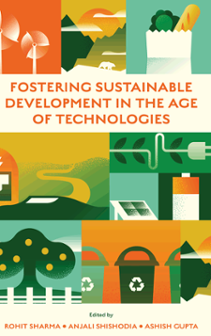
Index
Fostering Sustainable Development in the Age of Technologies
ISBN: 978-1-83753-061-8, eISBN: 978-1-83753-060-1
Publication date: 13 December 2023
Citation
(2023), "Index", Sharma, R., Shishodia, A. and Gupta, A. (Ed.) Fostering Sustainable Development in the Age of Technologies, Emerald Publishing Limited, Leeds, pp. 359-368. https://doi.org/10.1108/978-1-83753-060-120231025
Publisher
:Emerald Publishing Limited
Copyright © 2024 Rohit Sharma, Anjali Shishodia and Ashish Gupta. Published under exclusive licence by Emerald Publishing Limited
INDEX
- Prelims
- Chapter 1 The Role of Digital Technology in Achieving Sustainable Development Goals (SDGs): A Systematic Literature Review, Bibliometric Analysis and Content Analysis
- Chapter 2 Digital Technologies, Sustainable Development Goals and the Grand Societal Challenges in the Context of Slum Dwellers of Kolkata, India
- Chapter 3 Blockchain and Artificial Intelligence Technology in Professional Services
- Chapter 4 Confrontation Strategy for Evolution of Future Employment
- Chapter 5 Framing the Digital Transformation Journey for Sustainability Based on the Lenses of Integrated Skills and Competencies for Future Work
- Chapter 6 Role of Social Networking Technologies in Developing Public Services Supply Chain During COVID-19
- Chapter 7 Adopting Technology for Sustainable Development: Reflections on Innovative Ecosystem
- Chapter 8 Exploring the Relationship Between Digital Initiatives, Dynamic Capabilities and Market Performance: A Conceptual Framework
- Chapter 9 Reverse Logistics: Rebuilding Smart and Sustainable Transformation Based on Industry 4.0
- Chapter 10 Reflections on Sustainable Development, Sustainability and Business Practice: Lessons From Measurement, Scalability and Bias in Artificial Intelligence (AI)
- Chapter 11 Digital Healthcare and Patient Transformation: Review Research and Future Agenda
- Chapter 12 A Comparative Framework Analysis of the Strategies, Challenges and Opportunities for Sustainable Smart Cities
- Chapter 13 Leveraging Blockchain Technology in Adopting Digital Tokenization of Green Bonds
- Chapter 14 Digital Technologies and Education for Sustainable Development
- Chapter 15 Safety Management in the Era of Emerging Industrial Revolution: The Conceptualisation of Safety 4.0
- Chapter 16 Spiritual Approach Among Techies: An Approach for Achieving Sustainable Development
- Chapter 17 The Evolution of Manufacturing: A Comprehensive Analysis of Industry 4.0 and Its Frameworks
- Chapter 18 Application of Industry 4.0 Technologies in Climate-Smart Agricultural Practices
- Chapter 19 The Digital Revolution – Implications of Digital Technologies on Women's Workforce Participation
- Chapter 20 Building Resilience Against Ongoing and Future Pandemics: Blockchain Technology to the Rescue
- Chapter 21 Impact of Awareness on the Adoption of Electric Vehicles: A Systematic Literature Review
- Index